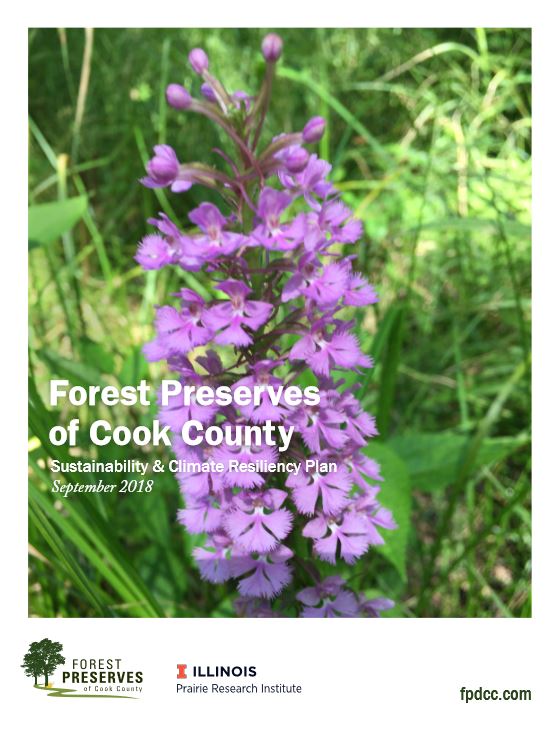
Project Title: Forest Preserve District of Cook County Sustainability & Climate Resiliency Plan
Sector: Parks and Recreation
Location: Forest Preserves of Cook County, Illinois
Services: Resilient Solutions (Climate Resiliency), Sustainability Planning, Fostering Sustainable Behavior, Implementation Assistance
Background: In 2014 the Forest Preserve District of Cook County (Forest Preserves), a public agency responsible for protecting and preserving nearly 70,000 acres of natural areas and public open space, engaged ISTC’s Technical Assistance Program (TAP) to evaluate the current state of materials management operations, assess opportunities for improvement, and take steps toward making the Forest Preserves a national leader, among similar organizations, in waste reduction practices. The success of that project led the Forest Preserves to engage TAP to assist in developing and implementing their Sustainability and Climate Resiliency Plan.
Approach: The process of developing this Plan, nine months in the making, included an internal and external review of past sustainability efforts, focus groups and engagement sessions across the operations within the Forest Preserves and Cook County government, and numerous topic-specific meetings. Priorities outlined in the plan, and their underlining strategies, reflect the Forest Preserves’ direction for a sustainable future.
This Plan is based on the vision, described in the Forest Preserves’ Next Century Conservation Plan, of being a leader in sustainable practices. As an important part of their founding mission to protect and preserve our public lands and waters, the Forest Preserves of Cook County commit to using sustainable and low-impact practices in operations and challenge ourselves to consistently perform all our functions in the most environmentally responsible ways.
Results: Published in September 2018, the plan hinges upon an overall goal to reduce the Forest Preserves’ greenhouse gas emissions by 80% by 2050 from a 2016 baseline. It also identifies a road map for Forest Preserve lands to be resilient in a changing climate, recognizing that such conditions will significantly impact land management operations as the range and distribution of species shift, along with the availability of water and other key aspects of the local ecosystem.
The plan is divided into five priority areas:
Utilities & Emissions
- Focus areas include GHG emissions measuring, reporting and reductions; green infrastructure integration; and water use tracking and efficiency
- Major objectives include reducing energy consumption by 4.5 percent annually and developing green building and site standards for future projects
Preserve Operations
- Focus areas include transportation and waste and recycling
- Major objectives include reducing fuel usage by 4.5 percent annually and expanding the recycling program to all Forest Preserve facilities
Learning & Engagement
- Focus areas include awareness and visibility, community engagement, and employee engagement
- Major objectives include promoting green practices with permit holders and enhancing Earth Day sustainability programming
Ecological Sustainability
- Focus areas include natural resources management and practices
- Major objectives include establishing Mitigating Impacts to Nature Policy as well as a Native Seed Policy outreach plan
Implementation & Advancement
- Focus areas include green purchasing
- Major objectives include establishing a Green Purchasing Policy, establishing and promoting a plastic reduction campaign, and increasing energy rebates and incentives with utilities
The full 2018 plan with complete objectives and targets, is available at http://hdl.handle.net/2142/101837.
On January 22, 2019, in response to a United Nations International Panel on Climate Change report, which demonstrated that the consequences of man-made climate change will become irreversible in 12 years if global carbon emissions are not immediately and dramatically reduced, the Forest Preserves of Cook County Board of Commissioners unanimously adopted a Net Zero Resolution. This resolution revises the 80% GHG emissions reduction goal to net-zero by 2050, as well as reducing facility GHG emissions by 45% by 2030 and committing to the development of a renewable energy plan.
TAP is currently working with the Forest Preserves on plan implementation. This in part includes identifying the most advantageous renewable energy strategies, guiding evaluation of equipment in nearly 300 facilities for energy efficiency upgrades, developing a means to track emissions reduction efforts and progress, and updating the Sustainability and Climate Resiliency Plan accordingly.
To help accomplish their GHG reduction goals, TAP worked with the Forest Preserves to develop a Clean Energy Framework, which was adopted by the Forest Preserves of Cook County Board of Commissioners in June 2021.
Other projects with this client: https://tap.istc.illinois.edu/category/forest-preserve-district-of-cook-county/

